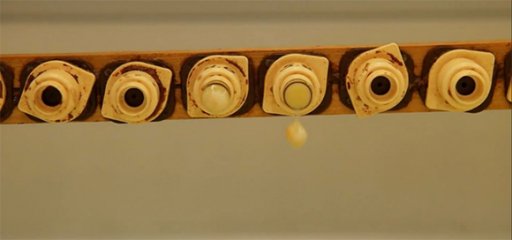
Honey bee larvae develop into queen bees only when they are fed large quantities of royal jelly. But royal jelly does more than determine whether a larva becomes a queen: it also keeps her safely anchored to the roof of the queen cell in which she develops. Research published in Current Biology on March 15 explains the role that the pH of royal jelly plays in making the substance viscous enough to keep the queen-to-be from falling.
“Royal jelly is kind of viscous and sticky and jelly-like; that’s why it’s called ‘jelly.’ It’s like a mixture of marmalade and honey,” says senior author Anja Buttstedt, a molecular ecologist who performed the study at Martin Luther University Halle-Wittenberg. And like jam in a jar turned upside down, it’s viscous enough to cling to the ceiling of the queen cell and to keep the larva hanging as she grows.
Larvae destined to become queens don’t have to hang to develop properly. But they are too large to fit into the cells of the hive’s honeycomb, and often the only place on the hive with enough room for the queen cells is hanging off the bottom of it. While other larvae are fed small amounts of food jelly directly, the worker bees stuff royal jelly into the queen cell in vast quantities, building up a sticky mass that both feeds the larva and keeps her in place.
This space constraint makes royal jelly’s viscosity extremely important, so Buttstedt and her team were surprised when their experiments on the proteins that make up the substance completely changed its consistency. “It was totally liquid, almost watery,” she says. To understand what had happened, the researchers looked at royal jelly, which normally has a pH of 4, at several different pH levels. They found that between pH 4 and pH 5, the viscosity of royal jelly changed dramatically, and that at a neutral pH, it had that strange, runny consistency.
“And then we realized that the protein that we were purifying at pH 4 was somehow much bigger in size than what we would expect from its amino acid sequence. Most purification protocols use pH 7, so other people never expected or saw the huge size of the protein,” she says. She found that the main protein in royal jelly, MRJP1, polymerized with another protein in more acidic conditions to form a network of fibers. These fibers both increased the size of the protein and played a crucial role in changing the jelly’s viscosity. “That was, in the end, the missing link between the pH, the viscosity change, and the protein,” she says.
It’s still unclear how these fibers change the viscosity of royal jelly. But she does have a good hypothesis for why the change is necessary: royal jelly is produced in the glands of worker bees and needs to be fluid enough to travel through their glandular ducts. Production of the jelly actually happens in two separate glands, one that produces the proteins in a neutral pH and one that produces fatty acids that can reduce said pH when the two secretions finally meet.
Other species have similar pH mechanisms that regulate the formation of crucial proteins. In humans, a protein that serves as scaffold for melanin synthesis only forms fibers at pH 6 in specific organelles. Another example is spider silk. “You don’t want it to be too sticky in the gland where it’s being produced, but when the silk is coming out, there are changes in pH that contribute to turning it into the real, strong silk,” she explains. So royal jelly’s pH-dependent viscosity change does make a lot of sense—it’s just that no one had ever looked at it before.
“The longer I think about it, the less surprising I find it,” Buttstedt says. Still, she plans to continue studying royal jelly and the ways it works to turn normal larvae into queens. “There are many other proteins in royal jelly, and I would like to find out what all of them are doing. Because these proteins exist in this way just in honey bees, they most likely use them to do something very special.”
This work was supported by the German Research Foundation and an ERASMUS+ exchange program grant.
Current Biology, Buttstedt et al.: “How honey bees defy gravity with royal jelly to raise queens” http://www.cell.com/current-biology/fulltext/S0960-9822(18)30207-0